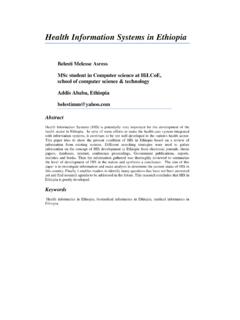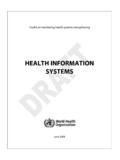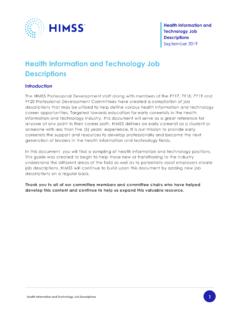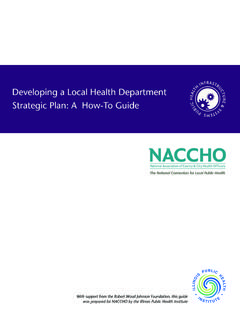Transcription of MONITORING THE BUILDING BLOCKS OF HEALTH SYSTEMS
1 AMONITORING THE BUILDING BLOCKS OF HEALTH SYSTEMS :A HANDBOOK OF INDICATORS AND THEIR MEASUREMENT STRATEGIESBWHO Library Cataloguing-in-Publication DataMonitoring the BUILDING BLOCKS of HEALTH SYSTEMS : a handbook of indicators and their measurement of HEALTH care. care quality, access, and evaluation. care evaluation mechanisms. HEALTH programs organization and administration. HEALTH 978 92 4 156405 2 (NLM classification: W 84) World HEALTH Organization 2010 All rights reserved. Publications of the World HEALTH Organization can be obtained from WHO Press, World HEALTH Organization, 20 Avenue Appia, 1211 Geneva 27, Switzerland (tel.: +41 22 791 3264; fax: +41 22 791 4857; e-mail: Requests for permission to reproduce or translate WHO publications whether for sale or for noncommercial distribution should be addressed to WHO Press, at the above address (fax: +41 22 791 4806; e-mail: designations employed and the presentation of the material in this publication do not imply the expression of any opinion whatsoever on the part of the World HEALTH Organization concerning the legal status of any country, territory, city or area or of its authorities, or concerning the delimitation of its frontiers or boundaries.))
2 Dotted lines on maps represent approximate border lines for which there may not yet be full mention of specific companies or of certain manufacturers products does not imply that they are endorsed or recommended by the World HEALTH Organization in preference to others of a similar nature that are not mentioned. Errors and omissions excepted, the names of proprietary products are distinguished by initial capital reasonable precautions have been taken by the World HEALTH Organization to verify the information contained in this publication. However, the published material is being distributed without warranty of any kind, either expressed or implied. The responsibility for the interpretation and use of the material lies with the reader. In no event shall the World HEALTH Organization be liable for damages arising from its by the WHO Document Production Services, Geneva, Switzerland Editing and Design: In s Communication THE BUILDING BLOCKS OF HEALTH SYSTEMS :A HANDBOOK OF INDICATORS AND THEIR MEASUREMENT STRATEGIESiiAcknowledgementThis document was developed through a collaborative process with inputs from country HEALTH SYSTEMS experts from around the world, the World HEALTH Organization, the World Bank, the Global Fund to Fight AIDS, Tuberculosis and Malaria, GAVI, MEASURE, HEALTH Metrics Network, UNICEF and others.
3 Particular thanks to all those who contributed to the meetings on HEALTH SYSTEMS MONITORING in Glion, Switzerland, 28-29 September 2006, and in Dar es Salaam, United Republic of Tanzania, 16-17 April 2008. This publication was produced by the World HEALTH Organization. WHO is particularly grateful to Ed Bos at the World Bank for his valuable contributions throughout the ivIntroduction and objectives of the handbook v1 HEALTH service delivery 12 HEALTH workforce 233 HEALTH information SYSTEMS 434 Access to essential medicines 595 HEALTH SYSTEMS financing 716 Leadership and governance
4 85 Abbreviationsiv Introduction and objectives of the handbookAbbreviationsARVantiretroviralDQ AFData Quality Assessment FrameworkGAVIG lobal Alliance on Vaccines InitiativeGDDSG eneral Data Dissemination StrategyGFATMG lobal Fund to Fight AIDS, Tuberculosis and MalariaGDPgross domestic productGGEgeneral government expenditureGGHE general government expenditure on healthHAIH ealth Action InternationalHISPIXH ealth information system Performance IndexHIV/AIDS human immunodeficiency virus/acquired immunodeficiency syndromeHMISH ealth Management information SystemHMNH ealth Metrics NetworkHRISH uman Resources information SystemIHP+International HEALTH Partnership and related initiativesICPDI nternational Conference on Population and DevelopmentIHRI nternational HEALTH RegulationsIMCII ntegrated Management of Childhood IllnessIMFI nternational Monetary FundISCEDI nternational Standard Classification of EducationISCOI nternational Standard Classification of OccupationsISICI nternational Standard Industrial Classification of all Economic ActivitiesMDGM illennium Development GoalMSHM anagement Sciences for HealthNHAN ational HEALTH
5 AccountsNGOnongovernmental organizationNMPN ational Medicines PolicyOECDO rganisation for Economic Co-operation and DevelopmentOOPout-of-pocket spendingPEPFARU nited States President s Emergency Plan for AIDS ReliefSHAS ystem of HEALTH AccountsTHEtotal expenditure on healthTPEtotal pharmaceutical expenditureUSAIDU nited States Agency for International DevelopmentWHOW orld HEALTH Organization Abbreviations Introduction and objectives of the handbookvIntroduction and objectives of the handbookIn recent years, significant progress has been achieved in delivering HEALTH -related interventions that are designed to achieve goals relating to improving maternal and child HEALTH , and reducing mortality and ill- HEALTH due to HIV/AIDS, tuberculosis and malaria. It is increasingly apparent, however, that the gains have been neither universal nor sufficiently broad-based and sustainable. Progress at the national level has not necessarily resulted in gains for most vulnerable population groups; in some instances, progress has stagnated or been reversed.
6 There is mounting evidence that HEALTH SYSTEMS that can deliver services equitably and efficiently are critical for achieving improved HEALTH status. Thus, many global HEALTH initiatives now incorporate attention to HEALTH SYSTEMS strengthening in the support they provide to this increased attention to the strengthening of HEALTH SYSTEMS is welcome, it would not be sustainable in the absence of a sound MONITORING strategy that enables decision-makers to accurately track HEALTH progress and performance, evaluate impact, and ensure accountability at country and global levels. Moreover, the use of results-based financing mechanisms by major global donors has created a further demand for timely and reliable data. There is also increasing in-country demand for data in the context of annual HEALTH sector is needed to track how HEALTH SYSTEMS respond to increased inputs and improved processes, and the impact they have on improved HEALTH indicators.
7 This implies the need to define core indicators of HEALTH system performance while developing and implementing appropriate sustainable measurement strategies to generate the required data. However, on the supply side, there are major gaps in data availability and quality. Few developing countries are able to produce data of sufficient quality to permit the regular tracking of progress in scaling-up HEALTH interventions and strengthening HEALTH SYSTEMS . Data gaps span the range of input , process , output , outcome and impact indicators: few countries carry out regular national HEALTH accounts studies; data on the availability and distribution of HEALTH workers are often incomplete, inaccurate and out of date; few countries have SYSTEMS that can monitor service delivery; and data on population access to essential services are limited. Introduction and objectives of the handbook vi Introduction and objectives of the handbook What is a HEALTH system ?
8 A HEALTH system consists of all the organizations, institutions, resources and people whose primary purpose is to improve ,2 This includes efforts to influence determinants of HEALTH as well as more direct HEALTH -improvement activities. The HEALTH system delivers preventive, promotive, curative and rehabilitative interventions through a combination of public HEALTH actions and the pyramid of HEALTH care facilities that deliver personal HEALTH care by both State and non-State actors. The actions of the HEALTH system should be responsive and financially fair, while treating people respectably. A HEALTH system needs staff, funds, information , supplies, transport, communications and overall guidance and direction to function. Strengthening HEALTH SYSTEMS thus means addressing key constraints in each of these for MONITORING HEALTH SYSTEMS performanceThe multifaceted nature of HEALTH SYSTEMS and the spread of direct and indirect responsibilities across multiple sectors, pose challenges in MONITORING performance.
9 In response, over the past several years, the World HEALTH Organization (WHO) and its partners have been working to reach a broad-based consensus on key indicators and effective methods and measures of HEALTH SYSTEMS capacity, including inputs , processes and outputs , and to relate these to indicators of outcome . It is widely known that there are many potential advantages of a harmonized approach to HEALTH SYSTEMS MONITORING and evaluation, including reduced transaction costs, increased efficiency, and diminished pressures on countries. However, there are also identified practical issues to be addressed before greater harmonization can become a reality. The existence of multiple analytical and strategic frameworks for HEALTH SYSTEMS results in considerable potential for duplication, overlap and Existing frameworks include the WHO framework for HEALTH SYSTEMS performance assessment (1); the World Bank control knobs framework (2); and the WHO BUILDING BLOCKS framework (3).
10 Such frameworks have varying starting points, resulting in emphases on different outcomes to be tracked. Work is on to develop conceptual frameworks for HEALTH SYSTEMS strengthening and to create a taxonomy that would permit clarification of the indicators, data sources and collection methods, and the analytics underpinning MONITORING and evaluation. However, the choice of the strategic framework does not necessarily substantively affect the MONITORING and evaluation strategy. There are many commonalities in the various strategic frameworks for HEALTH SYSTEMS that permit a coherent approach to the choice of indicators and measurement SYSTEMS framework and BUILDING blocksThis handbook does not attempt to cover all components of the HEALTH system or deal with the various MONITORING and evaluation frameworks. Instead, it is structured around the WHO framework that describes HEALTH SYSTEMS in terms of six core components or BUILDING BLOCKS : (i) service delivery, (ii) HEALTH workforce, (iii) HEALTH information SYSTEMS , (iv) access to essential medicines, (v) financing, and (vi) leadership/governance (see Figure 1).

















